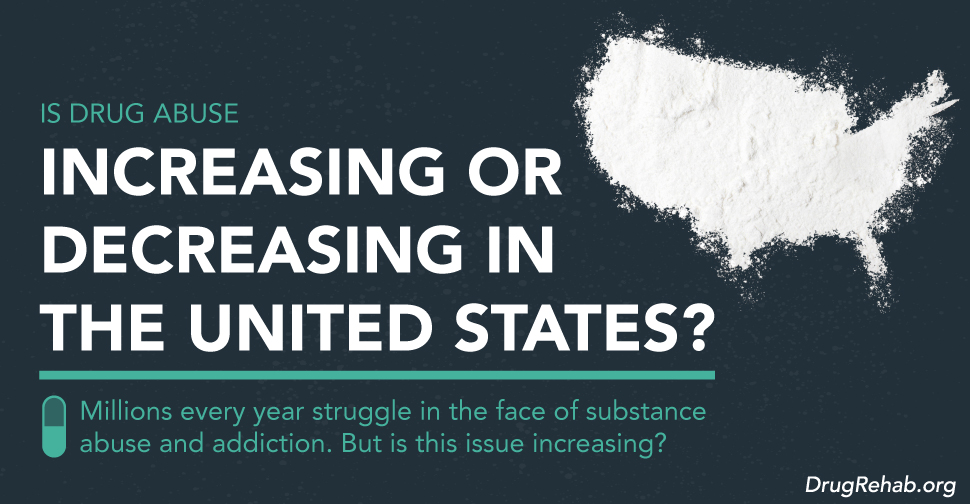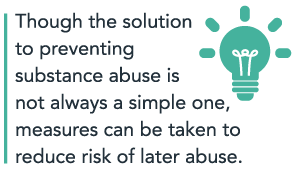
If you live in the United States, you may have noticed the substance abuse problem which plagues so many people. Millions every year struggle in the face of substance abuse and addiction. But is this issue increasing in the United States? The answer is not a simple one.
To start, drug trends are measured individually and as a whole. In other words, trend reports are taken on individual abuse of specific drugs, such as heroin, marijuana, and cocaine. Then, overall drug abuse is measured in total. In addition, demographics are measured in regards to who is abusing drugs, from which race, to which age, to which sex, and more. Finally, overdose rates are also measured to see which substances are having the most dangerous impacts on society.
Understanding Drug Abuse Trends
To fully understand whether drug abuse is increasing or decreasing, it is necessary to understand some facts about drug abuse:
- “More than half of illicit drug users begin with marijuana,” according to the National Institute on Drug Abuse (NIDA).
- The second most commonly abused substance (for new, illicit drug abuse) is prescription medications.
- Many people first try substances recreationally during teen years.
- Drug abuse occurs most in people aged between teen years to the early twenties.
- Alcohol disorders/ binge drinking are more common among men than women.
- Alcohol is the most abused substance after marijuana.
- There is a “treatment gap” according to NIDA. Only a small percentage of people who need treatment for substance abuse receive the care they need.

As NIDA states, marijuana abuse is increasing. Reports in 2013 showed marijuana use for the U.S. equated to 7.5% of the population, or 19.8 million people. This number reflected an increase from the 2007 report, which showed 5.8%, or 14.5 million people. Perhaps some people consider marijuana a harmless, natural substance. Indeed, many Americans are pushing for the legalization of it.
Despite this, it is currently an illegal substance, with growing trends of abuse in recent years. Further, marijuana is considered a “gateway” drug; while it may not have all the staggering health effects of other drugs, and many believe it is not highly addictive, it may lead to abuse of other substances. It is in this way that the increase in marijuana abuse is troubling. It is important to note here, that marijuana has been shown to be addictive, and that it also carries significant health risks, including decreased amounts of dopamine, and a possible link to depression and schizophrenia.
According to the National Institute on Drug Abuse, illicit drug use has increased. They report that in 2002, 8.3% of the population used these drugs, in comparison to the 9.4% in 2013. A welcome fact, however, is that NIDA shows that the numbers for most types of drug abuse are decreasing, or at least remaining stable, and they do note that this overall increase is due mainly to the surge in marijuana use. When looking at staggering numbers, such as the 6.5 million people in the U.S. who had abused prescription drugs over one month’s span in 2013, or the 1.3 million who abused hallucinogens, this may not seem like good news. What is important to remember is that these numbers are not on the rise.

Further, abuse of cocaine has actually decreased. Reports of cocaine abuse totaled 1.5 million in 2013—a significant decrease from the 2.0 to 2.4 million estimated during 2002 to 2007. Methamphetamine abuse increased by a margin of nearly two-thirds from 2007 to 2013. But alcohol abuse, one of the most commonly abused substances saw a slight decrease both in underage binge drinking and in incidents of driving under the influence.
Reports from the National Survey on Drug Use and Health, as referenced by the American Society of Addiction Medicine in 2014, reflected the same trends. That is, marijuana abuse continued to increase, many other substance abuse forms stabilized, and another significant, troubling trend: heroin abuse is also on the rise.
One article in Forbes suggests some reasoning behind the continued uprise of heroin abuse. First, the overall decrease in abuse among other substances made way for an increase in other drug abuse; heroin closed this gap. Also, heroin may be more readily available to those afflicted with substance abuse, as it is more affordable, especially when compared with other narcotics, such as prescription drugs. Another possibility is that prescription opioids may be the gateway to use of more harmful narcotics, such as heroin. Once a person no longer has a prescription, but has developed an addiction, he or she may undergo compulsive cravings and a need to fill the void.
 In sum, though drug abuse trends are rising overall, some are decreasing or becoming stable. This trend accounts for millions of people in need of substance abuse treatment. The percentage of people that actually make it into treatment is far too low, and that is a fact which cannot be ignored.
In sum, though drug abuse trends are rising overall, some are decreasing or becoming stable. This trend accounts for millions of people in need of substance abuse treatment. The percentage of people that actually make it into treatment is far too low, and that is a fact which cannot be ignored.
Decreasing Drug Abuse
So what is the missing link needed to help decrease current substance abuse trends? Treatment. Preventative measures and treatment may significantly help decrease the numbers. For instance, there are certain risks associated with abuse. Protective factors may help prevent these risks—a child who grows up with lack of parental involvement or care may be at a heightened risk for substance abuse later in life. The preventative protective factor in this case would be increased parental involvement. Though the solution to preventing substance abuse is not always a simple one, measures can be taken to reduce risk of later abuse.
Treatment for those afflicted with substance abuse is available in many forms. Therapy exists to treat physical, mental, and emotional health. Cognitive behavioral therapy is one type, and works by teaching participants to form new lifestyle habits which build a life without substance abuse. Research finds that medication therapy helps greatly to ease the withdrawal process, or to help wean off substance use. Others may benefit from counseling, which helps people to cope with the range of emotions and thoughts that can result from substance use disorders. In any treatment decision, though, it is imperative that one has access to resources and information to make the process go as smoothly as possible.
Reversing The Trend: Get Help For Substance Abuse Treatment
 The increase in illicit drug use is great cause for concern. Overdose rates for heroin continue to rise, and abuse of alcohol, marijuana, and prescription drugs remain high, even if they are not changing significantly. But the ever glimmering hope within these dark facts is that treatment is available. Too many people do not get the help they need and deserve, but you do not have to be one of them. Contact us today at DrugRehab.org for more information on treatment, connection to resources, and to begin your recovery.
The increase in illicit drug use is great cause for concern. Overdose rates for heroin continue to rise, and abuse of alcohol, marijuana, and prescription drugs remain high, even if they are not changing significantly. But the ever glimmering hope within these dark facts is that treatment is available. Too many people do not get the help they need and deserve, but you do not have to be one of them. Contact us today at DrugRehab.org for more information on treatment, connection to resources, and to begin your recovery.
Sources
American Society Of Addiction Medicine—Increased Marijuana, Heroin Use
Drug War Facts—Drug Use Estimates
National Institute On Drug Abuse—Drug Use Trends Remain Stable Or Decline Among Teens
National Institute On Drug Abuse—DrugFacts: Nationwide Trends
National Institute On Drug Abuse—Is Marijuana A Gateway Drug?

